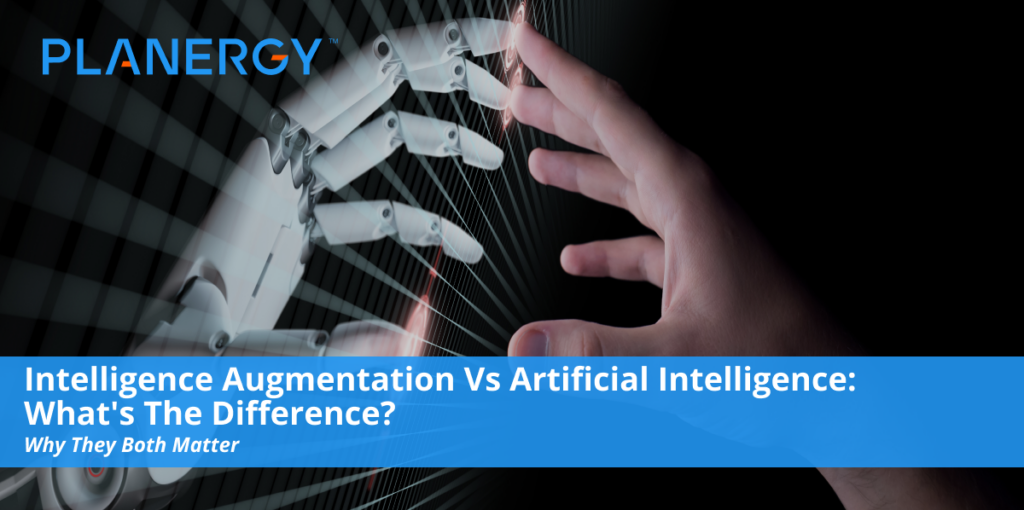In the last five years or so there has been a great deal of hype around and artificial intelligence and intelligence augmentation.
While they may seem to be futuristic technologies, it’s important to understand why we need them and the exact role each technology can play in our lives.
What is Intelligence Augmentation?
Intelligence augmentation, or IA, is another conceptualization of AI or artificial intelligence. It focuses on the assistive roles of AI with emphasis on the fact that it is meant to enhance human intelligence rather than replace it.
You may also hear it referred to as intelligence amplification, assistive intelligence, machine augmented intelligence, or cognitive augmentation.
The technology focuses on the effective use of information technology in augmenting human intelligence. The systems work to enhance human intelligence and improve human decision-making functions in some way.
IA was designed as a result of fears and concerns about AI as a whole. As AI has evolved and become more robust, there is a concern that AI technology may impact human life negatively.
IA, many believe, offers a safer way to develop tools and technologies that gain their efficacy from human consciousness rather than building their own artificial intelligence.
Tools developed through IA can be used for a variety of purposes such as image processing tools, natural language tools, developing knowledge bases, and electronic discovery to name a few.
What is Artificial Intelligence?
Artificial intelligence (AI), which may also be referred to as machine learning, Refers to intelligence demonstrated by machines in contrast to the intelligence shown in humans.
AI is a part of computer science that focuses on creating intelligent machines that react and work like humans but perform better. AI is designed for a variety of core activities, such as:
- Learning
- Speech Recognition
- Planning
- Problem-Solving
- Reasoning
- Knowledge
As machines become increasingly capable, tasks thought to require intelligence have been eliminated from the definition which is known as the AI effect.
AI was first created in 1956 as an academic discipline. It has been divided into various subfields, with each subfield divided into technical consideration, use of certain tools, and social factor consideration.
AI may be the segment most of us are familiar with, but IA is highly similar and many of us have been using it, even if unknowingly, for some time.
Intelligence Augmentation Vs. Artificial Intelligence
These two buzzwords are often used interchangeably because they are parts of the same coin, and there is confusion about how the two are different from one another.
Use the term AI when you’re discussing the broader concept of machines being able to perform tasks that humans would perform in ways that we consider smart or intelligent.
Use the term intelligence augmentation when you were referring to an application of AI, based on the idea that we must provide machines access to data and let them learn by themselves.
Artificial intelligence in the workplace is important for IT Mimicking cognitive functions such as learning and problem-solving. It can work wonderfully for the level admin tasks, onboarding, booking meeting rooms, or even organizing a calendar.
AI can provide extreme benefits when it analyzes big data to enhance and accelerate business decisions, depending on the level of investment a business makes in its processing and computing power. AI focuses on the goal of using it to design automated systems that replace human cognitive function.
On the contrary, intelligence augmentation uses technology to support and complement human cognitive functions. While the buzz has been about AI for several years, intelligence augmentation has been moving forward, and its job is to make jobs easier.
Intelligence augmentation uses machine learning technologies that are similar to AI, but instead of replacing humans, it aims to assist them. In this situation, instead of depending solely on machines for business procedures, IA machine learning works in combination with the brain to empower each other.
IA aims to make the workplace more efficient and productive just like AI, however, IA does it in partnership with humans to support new discoveries and problem-solving while AI seeks to bypass humans altogether.
For instance:
Let’s consider a machine learning algorithm that can process massive amounts of patient data by searching through family history, patient history, previous records and tests, data from wearables and more to predict the illness.
But, the information will be presented to medical staff in a way that supports the doctor, who would use their reasoning to reach a prognosis.
Because the human element, the doctor, is still involved, this is IA. But if the program is sorting the data and reaches the prognosis is itself, then it would be AI.
AI will never replace the knowledge work entirely but IA can make things easier by saving time and improving efficiency.
Real-Time Applications of AI in Our Lives
Virtual Personal Assistants
Alexa, Cortana, Google Now, and Siri are all intelligent digital personal assistants for the various platforms we use every day including Android, Windows, and iOS. When you ask them a question using your voice, they help you find valuable information.
For instance, you can ask them where the nearest Chinese restaurant is or what’s on your grocery list and the assistant will respond with the correct information.
Smart Home Devices
Many home devices now offer the ability to learn your behavior patterns and adjust the thermostat settings accordingly. Because of this you can get better convenience and save energy which helps you save money.
For instance, you can adjust your thermostat when you leave for work and based on your return time, the thermostat will adjust accordingly so that your home is a comfortable temperature when you return, but doesn’t waste energy heating it when no one is home.
Security Surveillance
When it comes to humans monitoring different video cameras, it’s not a secure system. People easily get bored and find it difficult to keep track of multiple monitors.
As such, training computers to handle the monitoring of cameras is a great idea.
Using security algorithms, which can take input for security cameras, so the computers can identify a threat and notify the appropriate people when one is detected.
Fraud Detection
Have you ever received an email, phone call, or text message from your bank asking if you made a certain purchase on your credit card?
Banks send these kinds of communications if they believe there is a chance that fraud has been committed on your account.
It is an attempt to stop fraudulent activity before it gets out of control. Banks use AI technology to monitor activity for potential fraud.
Online Customer Support
Many websites offer their customers the chance to chat with a customer support representative while browsing. In many of these situations, you are talking to basic AI.
The chatbots aren’t much more than automated responders, but some of them are able to extract Knowledge from the site and present it to customers when they ask for it.
Real-Time Application of IA in Our Lives
Engineering
Innovative technology has disrupted manufacturing and production. With IA, there is another tool for maintenance and creation of complicated and expensive machines which makes it easier for engineers to make repairs.
For example, NGRAIN, a Canadian 3D imaging company uses 3D analytics to scan and detect minor damage to aircraft and uses the information to repair operations and improve maintenance.
Medical
When it comes to complicated medical procedures, using IA technology could improve them significantly.
Researchers all over the globe are developing tools. Cambridge consultants have determined potential solutions by combining CT and MRI scans to build 3D images of a person’s body.
This assist surgeons to perform more precise surgical processes.
Military
Intelligence augmentation could be used in high-fidelity visualization. This enhances situation awareness and improved mission planning.
Using 3D models, it would be possible to carry out successful operations.
Retail
Integrating intelligence augmentation technology into shopping applications can make it easier for Shoppers to find products. for instance, the Walgreens app links to the user shopping card and uses Google Tango’s computer vision – a 3D mapping service – to guide in-store shoppers using a downloaded map.
Customers can search item numbers, product categories and product names by voice and command the mapping app to provide them store navigation instructions to the product’s location in the store
Home Decor
IKEA, one of the most well-known home decor companies, created an app with IA technology. It supports both 2D and 3D image recognition and image tracking. With this technology, users can move still photos of furniture and Furnishings into an image of a room.
It’s also possible to measure the dimensions of the room through the app and allow the users to drop an image of a piece of furniture into the photo. this way, Shoppers can see what their Ikea purchases will look like in their home before deciding what to buy.
In the end, there’s no war between the two technologies, trying to figure out which one is here to stay. Both of them play important roles in our day-to-day lives, and as technology continues to advance, they will represent larger parts of it.
IA can help address many of the challenges associated with AI, which is why the two are needed to work together. Doing so creates the greatest benefit toward society as a whole.




